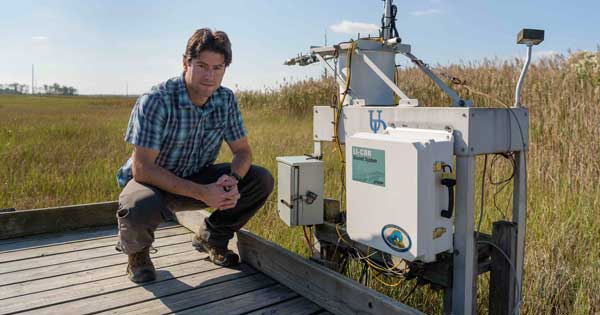


Big data for Carbon Monitoring Systems
Photo by Evan Krape April 11, 2018
UD’s Rodrigo Vargas works with NASA to map carbon dynamics across Mexico
The University of Delaware’s Rodrigo Vargas is partnering with NASA and an international team of collaborators to understand carbon dynamics in soils and diverse landscapes in Mexico. Using one of the agency’s high-performance computers, the group will study massive amounts of datasets to document carbon dynamics across the country.
Vargas, associate professor in the Department of Plant and Soil Sciences in UD’s College of Agriculture and Natural Resources, is leading the three- year, $800,000 project. Vargas’ work is a continuation of a previous project that led to over 20 peer-reviewed publications and published datasets.
This new project aims to improve national carbon monitoring efforts and provide support for implementation of Reducing Emissions from Deforestation and Forest Degradation plus improving forest management, carbon stock enhancement and conservation (REDD+).
Co-Investigator Sangram Ganguly, senior research scientist at NASA Ames Research Center, has developed a machine learning approach implemented in the NASA Earth Exchange (NEX) high performance computing (HPC) framework to detect forest cover change across the United States.
Now, the researchers are interested to see if this approach using high resolution aerial imagery can be applied to Mexico, which has a more heterogeneous landscape.
“Mexico is a great test bed for NASA Carbon Monitoring System (CMS) products because it provides a heterogeneous landscape for testing,” Vargas said. “That’s extremely important because in a short distance, you can have very sharp changes in climate and the land surface from deserts, tropical forests, all the way to tundra so this landscape heterogeneity makes a challenge for monitoring applications.”
Vargas said the motivation behind the project is to allow NASA to develop and improve capabilities to support stakeholders — such as the U.S. Forest Service, the National Forestry Commission of Mexico and the North American Carbon Program — to improve monitoring, reporting and verification of carbon stocks and fluxes across North America.
“This is about big data processing for training algorithms,” Vargas said. “This is about using the wealth of information to increase our capabilities for carbon monitoring systems. We want to generate a framework using different variables and then, through collaboration with stakeholders, improve national carbon monitoring.”
The researchers are collecting datasets from Mexico to create harmonized information that will allow them to study terrestrial carbon dynamics from local to regional levels. This will be important to test and improve the applicability of NASA CMS products elsewhere other than the United States.
“The data that is available in the United States is unique but Mexico is a country that has developed a lot of important and useful datasets that can now be used to test the U.S. derived technologies,” Vargas said. “Also because of the proximity of Mexico to the United States, some information of Mexico is covered by satellites of the United States because of the shared border. So many of the products that are designed for the U.S. can be independently tested in Mexico.”
By using remote sensing and ground information coupled with a HPC framework, the researchers are hoping to not only increase the knowledge in carbon cycle science but also reduce the costs associated with national-scale carbon monitoring.
“One step is to extract information and knowledge from remote sensing products, airborne platforms and intensive carbon monitoring sites to provide multi-scale benefits and knowledge on carbon cycle science,” Vargas said. “If you go and assign an inventory and say ‘I’m going to measure all the trees around the country,’ it could be very accurate but it’s super expensive. If you use a remote sensing approach, just by itself, it’s cheap but we need to test how accurate it could be.”
By extracting knowledge from intensive ground-based inventories of carbon stocks and fluxes to inform different approaches, the researchers are hoping to identify uncertainties to provide confidence in remote sensing products.
“What we’re trying to do in Mexico, is we have a lot of information for the inventories but also we have a lot of information from remote sensing. We want to put them together so we can maximize the efforts,” said Vargas.
The group will take advantage of available databases from Mexico and the United States on soil carbon and models of carbon fluxes across the countries which allows them to propose a methodology for forest classifications with regards to forest cover change assessments and an estimation of carbon related variables.
“We’re implementing techniques for land surface classification developed within the United States using HPC to test them to see how they perform in complex, heterogeneous landscapes in Mexico using new data sets,” Vargas said. “This is important to test but also to generate knowledge and inform stakeholders in Mexico to ultimately close the regional carbon balance across North America.”
Once the researchers provide a framework and their calculations, the outputs can be tested on the ground in collaborations with Mexican scientists for ground truth validation at intensive carbon monitoring sites.
“This builds on the goal of NASA CMS to build these prototypes to support monitoring, reporting and verification of carbon stocks and fluxes at different spatial and temporal scales,” said Vargas. “It brings the opportunity for UD to build international collaborations and build international reputation and it’s important for closing the regional carbon budget of North America.”
Vargas said that the project lines up nicely with UD’s new data science initiative and he has also been collaborating with researchers from multiple institutions to look at ecological data to help improve near-term ecological forecasting.
Contact Us
Have a UDaily story idea?
Contact us at ocm@udel.edu
Members of the press
Contact us at 302-831-NEWS or visit the Media Relations website

